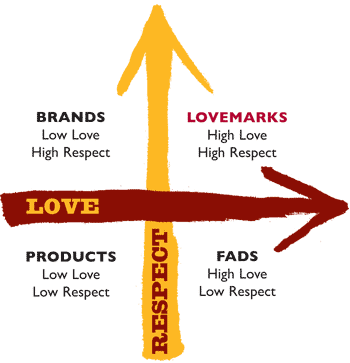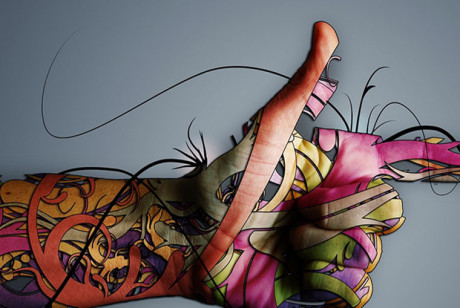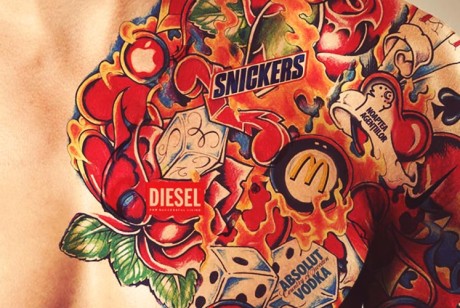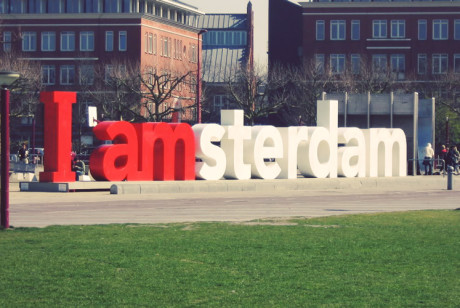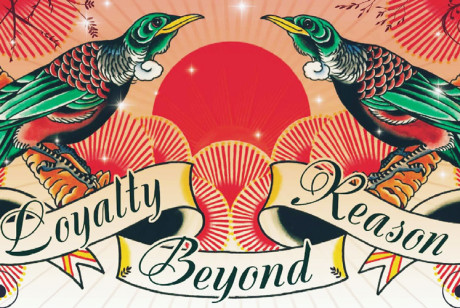The Power of Love
Tuesday, 17 October 2000 - Amsterdam, Netherlands

Presentation Summary
An address to the Adtech Europe 2000 Conference. A provocation aimed at the dot com deadpool: several arguments in favour of television, mass marketing, building billion dollar brands, becoming a Lovemark, the Evernet, moods, brains, Xena and Maximus, research vampires, respect, trust and love.
This is my second AdTech and I’m excited that this time it’s in Amsterdam. This city is one of the last “dangerous 24 hours a day” cities. It’s our kind of place, right? Because that’s what our business is about: excitement, energy, the edge of risk and maybe danger.
A lead speaker usually has two options: flatter the hell out of the audience to get a good vibe going, or issue a challenge by throwing out some red meat. In New Zealand we go the challenge route.
Dot-Com World Needs Emotional Rescue
At AdTech in San Francisco I proposed that the dot-com world needed emotional rescue – from deadening functionalism, rationalism and all the other ism’s lurking in the shadows. Well they haven’t gone away. Indeed they’ve become stronger. Fed by metric mania and an obsession with process.
Just look at the title of this conference. Ad:Tech. Just like military intelligence. An oxymoron. Who’s here to pick up techniques and technologies? I hope we’re here to expand the advertising world. To explore the emotional world and the boundaries of what’s possible when they push up against what’s practical.
The programme promises you “strategies for success”. That’s a big call. But let me make a start. If you want to be successful every time, everywhere, in every medium, you need one thing…
Heart. I’m talking emotions.
Shocking Four Letter Word
And, as I made clear in last month’s Fast Company, I’m talking a four-letter word that profoundly shocks too many of my colleagues….Love.
Remember the power of Love over the next three days as you listen to techies, watch demos, fill your bag with pamphlets and your PDA with URL‘s, keep focused. As Van Morrison says: “Turn on your love light” – and keep it on!
I was a client of advertising for thirty years and I’ve only been in the business with Saatchi & Saatchi for three, but it sure is where all the fun is.
I’ve pushed hard for Saatchi & Saatchi to be an ideas company.
It’s weird to read through this programme and see so much emphasis on the dead-end of technical expertise. Creativity is not device dependent. It’s not about technology. Think with your mind, or better still with your heart. Sure expertise has its value – no doubt about it – but big-time, enduring success depends on ideas, creativity and a profound understanding of human – and even animal emotion.
It’s great that the First Annual AdTech Europe Awards will be presented in the next few days. Yes, recognise serious creative effort, but next time ask whether it is only “innovative online advertising and marketing campaigns” you want to honor. Are great ideas only great ideas if they fit into a campaign, into a set format?
Ideas with La Difference
At Saatchi & Saatchi we don’t think so. We’ve just announced the winner of our second Innovation in Communication Award in New York.
It was a tough call for our brilliant judges: Wired biologist Kevin Kelly, physicist Paul Davies, Edward de Bono, multimedia artist Brian Eno, economist Kjell Nordstrom and software agent pioneer Pattie Maes. Their mission was simple: find something that has the potential to revolutionize communications. This year’s winner was sensational.
The grand prize of one hundred thousand U.S. dollars went to Peratech from the UK. Their remarkable new compound promises us a future of roll-up keyboards and smart clothing.
Our Innovation Award illustrates the core purpose of Saatchi & Saatchi: to create world-changing ideas that transform our clients’ businesses, brands and reputations. Now that we’re part of Publicis Group it’s about ideas with La Difference.
Since I’ve been with Saatchi & Saatchi I’ve seen the online commerce world expand, distort, rocket and plunge. What’s going on?
Obsession with Metrics
What sticks in my eye is the obsession the Internet world has with numbers. With metrics. I run a global company with billings of over seven billion U.S. dollars. Zeroes don’t scare me. But online media and media about the online world seem to think that adding numbers to any statement will somehow make it come true. It won’t.
Everyone in advertising knows all about market research – love it or hate it. But we also know that any information worth a dime is carefully protected. If it gives us an edge we don’t go out there and splash it over the front page of the New York Times. So if the metrics in the media aren’t about competitive advantage, what are they for?
Maryann Jones Thompson of The Industry Standard has a suggestion: “There’s such a clamor for attention in the press that companies have learned that a great way to get publicity is to produce a study about your market and issue it as a story and have reporters pick it up.” The result? Insiders pumping up the percentages on business models that make no sense and certainly make no money. A PR effort in other words for cut-through in the attention economy.
To me this whole metrics circus plays on our human desire for certainty in an uncertain world. As long as it runs to two decimal points it has to be true.
The X-factor is what you in this room have got to be able to sniff out. Demographics and metrics won’t do it. Loving what you sell and loving who your customers are will. Feel what they feel. Know what they know. Mastery of technology can be a barrier to empathy. Structure and process can hide what I call the “I’s” and the “E’s”.
Ideas, imagination, intuition, insight, inspiration.
Emotion, empathy, energy, excitement, edge.
That’s what the ubiquitous “e” needs to stand for.
Emotion.
The Purpose of Advertising
The purpose of advertising is to sell more stuff. It’s as simple as that. We’re about more transactions, richer transactions, faster transactions, longer-term transactions, transactions that transform into relationships, into memberships, into fan clubs.
Any single item of advertising has about five seconds to work – often less. Advertising has to be a very fast thing. People just will not hand over their time to you willingly. Advertising must be an affair that starts with instant attraction.
Mass Marketing Rides
A declaration. I’m interested in billion dollar brands. Not a popular position here maybe because that makes me a mass marketer. I’m proud to be a “mass marketing maverick” riding against conventional wisdom, who’s passionate about scale, about shared emotion, about king hits and high ambition. Announcing mass marketing is dead does not make it dead. Announcing that online marketing has toppled mass marketing is a nonsense both in dollar terms and in human terms.
Online marketing is in its infancy whether it’s on PCs, PDAs, mobile phones or toasters. If you want to make serious money from it – or just break even – you’ll need not just angel investors but downright deities to keep you afloat. Sure online marketing is new. It’s exciting and full of potential. New ideas are being tossed around. Expectations are high. Experimentation rules. This is all great and what will evolve will be powerful and amazing.
There’s a downside to hype. No one wants to get left behind. We all want to show that we “get it”. That our great idea uses, say, peer-to-peer computing or zaplets in a new way. This jostling is a necessary part of change but it is also why companies crash and business models prove unsustainable. And once an idea fails, everyone knew it wouldn’t work.
If the losses weren’t so real it could be entertaining. The website www.fuckedcompany.com sure thinks so. It’s become the home of the dot com dead pool. The game is to pick companies that are fucked – in advance. They’ve got official rules, t-shirts. The works. It’s callous, it’s mean-minded, and I love it.
Now I want to turn from the profoundly cynical to the even more deeply unfashionable-television. TV. Still overwhelmingly analogue despite the promises, television remains the most effective tool ever developed for selling stuff by far. And that’s the idea, right? Selling stuff. The 30-second TVC. It has steadily pumped economies worldwide for decades – and it is pumping still.
Why am I Talking About Television
Why am I talking about television at AdTech? Because it sets the context within which we work. It’s been technically stable for decades. Its wildly successful business model has generated profits that have sustained shareholders for quarter after quarter. It shows why focusing on emotion not technology works. It is the most powerful mass medium invented bar none. It builds relationships faster and more enduringly than any other medium. That’s why we should be thinking about the lessons of television. Lessons that are fortunately not as life-threatening as this one.
I’ve been picking up new interest online about television. Why has it worked? How will it mesh with other technologies? What is it transforming into? I think such questions come out of bitter experience with over-hyped technologies that are not yet ready, a new urgency for profitability and a suspicion that consumers might not want to play.
I’ve been working with a model over the last year or so. I call it the Love / Respect Axis and it throws some light on what’s happening. It looks like this.
Love Respect Axis / The Evernet
I use the Axis to talk about brands and how most brands limit themselves. They obsess over Respect stuff, and don’t even aspire to Love. This morning I’m going to check out how television stacks up on the Axis. And I’m going to match it up against what I see being called the “Evernet”. Online, everywhere, all the time. In 1998 I was calling it “embedded or distributed computing”! Perfect for AdTech, right?
People LOVE television. They HATE it too, but they do both with passion. No one RESPECTS television – well no one I know. They love it. They hate it. And boy, do they watch it. Television spread faster than any other medium in history – and I’m including the Internet. There was a TV in 9 percent of households in 1950 and in 87 percent by 1960. Today it is everywhere. With its power to tell stories with emotion, drama, music and humor, it remains the most effective, the most persuasive and the fastest way to build brands.
So where does the “Evernet” sit on the Axis? This is tougher because it is still so fluid but on balance I’d have to go for Respect.
Access to information, shopping, news, deals. There’s not much sound, I’ve got to type, I’ve got to wait – I hate that – and I’ve got to do it on my own – I hate that even more. Where I do sense emotion, it is around stuff like dynamic pricing – eBay is an online drama of its own – personal obsessions, specialist communities and email! So TV takes out the “Evernet” on the Love/ Respect Axis today. Is change on its way? Most certainly.
TV’s Dream Run
While the “Evernet” may be out to transform itself into television on steroids, it’s not yet ready for prime time. Some simple insights from television’s decades-long dream run.
It’s got to work. Every time – or else:
There’s no margin for error here. The problems of online shopping show how unforgiving customers can be. If your success is based on delivery, then you’ve got to deliver. No question.
It’s got to be easy-to-use:
I personally feel even TV remotes are getting out of hand. When I talk about easy-to-use I’m talking real easy-to-use, not techie easy-to-use. They’re worlds apart. When perfect speech recognition arrives and you can shout at your appliances, that’ll be nirvana.
It’s got to give pleasure:
I’m including physical pleasure here – who ever got a stiff neck and burning shoulders from watching TV? Seeking pleasure has helped human beings become what they are. If it makes us feel good, we want more.
It’s got to work with other stuff people like to do:
While fortunes are being invested in the promises of convergence and interactive TV, regular folks are just getting on and converging and interacting all on their own. They’re not waiting for your ground-breaking appliance whether it’s Blackberry or MODO. We’re in the Age of Also: TV plus magazines; TV plus newspaper. TV plus email. TV plus web browsing. We have a gift for mix ‘n matching, reinventing, hybridising. Do-it-yourself convergence!
And alongside these four insights remember TV is changing at the same time. TiVO and digital are making sure of that. Nothing in the media business is in a static state. Nothing in the technology business is in a static state. And certainly nothing in the advertising business is static either. That’s why we love it, right?
Nothing in the media business is in a static state. Nothing in the technology business is in a static state. And certainly nothing in the advertising business is static either. That’s why we love it, right?
Brand Formula
Brand management is another arena where change has to happen dramatically. From being the great differentiator, the Holy Grail of marketing, the defender of business value, I have seen the very concept of brand become commodified. Just another formula in the armories of the mediocre and the uninspired. Here’s the sorry process.
Come up with a product. Trademark it. Give it a functional benefit. Write a marketing plan. Implement. The result? A great brand. Bullshit. Brands have smothered people with information. Now they’re suffering the death of a thousand yawns. A great brand has never had anything to do with all that stuff. A great brand has to be created with love, with inspiration, with emotion.
Lovemarks
Today such brands run so far ahead of the pack that I call them something else entirely. I call them Lovemarks. What makes Lovemarks stand out, what makes them more than brands, is mystery, sensuality and intimacy. Not exactly conventional brand attributes.
My intuition tells me that only a few, a very few of the great brands are also Lovemarks. I ran television and the “Evernet” through my Love / Respect Axis earlier. Let’s do the same for brands and Lovemarks.
Respect
This area of the axis is where brands sit. Respect earned by functional excellence, performance. Doing a good job. The bad news is that this is what consumers have come to expect. These days everyone has to be in the high respect quadrant just to stay in the game. But being there is not enough. It is head-driven, going nowhere.
This is where you’ll find research vampires too.
Contriving convoluted measures of respect, of market share, of sales. And what do they tell us? What people know, what they say and what they do. Not good enough. We need to understand what our customers feel. As Dylan Thomas said: what “makes them laugh or cry or yawn”. For the long-term health of a brand, for its elevation to a Lovemark, the big questions have to be: “Am I loved?” and: “How can I be loved more, faster, longer?”
It’s this other end of the Love/Respect Axis, the love end, that is truly important.
This is where we make connections with consumers and build dynamic organisations that create real value.
Passion, Spirit, Optimism
This is where the human spirit resides in the worlds of our dreams and aspirations. Ideas, great ideas, do their work in the heart and in the gut. They thrive in a rich mix of passion, spirit and optimism. When you’ve got them by the heart, their minds will surely follow.
Now we’ve mapped where Lovemarks sit, we need to move to what they are. I had one cut at it in the Fast Company interview in August.
www.lovemarks.com
I’ve also put up a site about Lovemarks and it would be great if you check it out and play around with the first version of a tool we call the Lovemarker. Let me know what you think, as this whole deal is very much a work in progress.
I’ve learnt in the past months that this Lovemark standing, this state of grace, is sought after by the Davids as well as the Goliaths. I’ve had micro-breweries, pizza makers, car audio specialists and a spiritual motivator for queer folk from this “dangerous” city of Amsterdam, all email me wanting the secrets of Lovemarks. I’ve had some heavy duty global companies after the same thing, but the Davids have given me a special insight. The adage about love holds true: to love others you first have to love yourself.
These people all LOVE what they do, and LOVE who they are doing it for. They’re permanently infatuated. If you’re remotely ambivalent about what you do, then you’ll never cut it, you’ll simply eke out life as a brand.
You don’t want that so here’s how I am currently defining the indefinable: the Lovemark.
Mystery
First up let’s look at mystery. I see Lovemarks wrapped in great stories and great metaphors. Many of them are spiced with secret ingredients and mythic characters. Some get an extra boost by combining the past with the present. All of them have that supreme ability to tap into our dreams and aspirations. Sure it is hard to quantify mystery. As Homer Simpson might say: “that’s why it is mysterious”. All I know is that it wells up from the rich alchemy of human emotion. And that when you find people starting fan clubs and trading collectibles, you’re close.
I was in Iceland a couple of months ago. I was told that the Icelandic dream is to own a Toyota Landcruiser. This is what 45 percent of Icelanders dream about. That’s incredible but when you experience Iceland you start to feel the connections between this mighty machine, the physical demands of this breath-taking place and a rich history of characters and myths. Add them all up: a Lovemark for Icelanders for sure!
Sensuality
Along with mystery I know a Lovemark has sensuality. They cry out to be touched. There is no way we can understand the world without experiencing it first through the radar of our five senses. Diane Ackerman says why:
“The latest findings in physiology suggest that the mind doesn’t really dwell in the brain but travels the whole body on caravans of hormone and enzyme, busily making sense of the compound wonders we catalogue as touch, taste, smell, hearing and vision.”
Now when you put mystery together with sensuality, customers melt into lovers and you’re on your way to a Lovemark. Want to see it in action? Check out www.harleymom.com.
Bizarre, sure. Kinda gross? I guess. In love with Harley-Davidson? You better believe it. Why is the Harley-Davidson a Lovemark? Let’s step through sensuality.
A motorcycle with a sound so distinctive and so coveted that they’ve patented it. The clean, sleek look of a true classic. The unique Harley-Davidson feel on the road – if you’ve ridden one you’ll know what I mean. That only leaves smell and taste. I’m not a bike guy myself but I know there’ll be a distinctive Harley smell of oil and fuel. And of course the taste of freedom. As Harley-Davidson says: “Throw the map in the trash and ride.”
Harleymom – or Tywla Gab to her friends – responds to the lot. She’s got the visuals, she’s got the music, she’s intertwined her life story with that of Harley-Davidson, and as for her customised white bike! Call in the anthropologists. Tywla sees herself as the companion of Xena, Warrior Princess. Great choice.
So a Lovemark has to score high on both mystery and sensuality. Then there’s that third force I see in Harleymom. You know it’s a Lovemark because people feel they own it. The current buzz about community, trust and loyalty fits right there. This is where New Coke trespassed to its cost when it changed its traditional formula and where Harley-Davidson excels.
Mystery, sensuality, intimacy. These three add up to Love. People have to love, truly love the experience. I’m not talking affection or even lust but that enduring love that allows for a few foibles. It is the sort of love that gets families through the hard times. The love that works on auto-pilot when you are distracted or inattentive. Love in the bank if you like.
Yum
Think about the passionate loyalty of Apple computer fans. It’s what kept them with Apple even when they were buying expensive, boring, beige boxes instead of the cutting-edge design they’d loved in the Macintosh. It’s the love that was rewarded when Apple got it together with the iMac.
A Lovemark willingly accepts that customers own it. The big plus? They will forgive you if you make a genuine mistake. Why? Because they love you.
I’m still working through this but I don’t think the Lovemark idea stops with products and services. It expands to places, to personalities, to whatever people love. There are fourteen elements of a Lovemark. Let’s test this proposition with the case of William Jefferson Clinton.
14 Ways to Love Bill Clinton
Controversial and flawed, my contention is that this President, in despite of what Christopher Hitchens writes, is a Lovemark.
#1: Great stories: A definite yes. There have been more column inches, more conversations, more jokes about this President than … Richard Nixon?
#2: Secret ingredients: Remember Clinton is an accomplished storyteller. What can you say about a man who not only had the sense of occasion to come from a town called Hope, but got away with claiming “I believe in a place called Hope”?
#3: Past and present together: A definite yes based on the charisma of power. Blending past, present and future is a key Lovemark ingredient.
Bill Clinton plays the gravitas of the Presidency with a modern twist. A nice updating tempered by a certain old-fashioned Southern charm.
#4: Inspiration: You get to be an “inspirational leader” just by being sworn in as President. You’ve got to lose it rather than earn it. Clinton came close to losing it.
#5: Taps into dreams: This gets complex but it’s got to be a yes. Sure there’s the great American Dream that anyone can become President, but Clinton entered American dreams through another door. Overt sensuality, great attraction: a bona fide dream boat.
#6: Mythic character: Absolutely yes. World Leader. The President, the lover, the penitent husband, the man of power driven by larger than life desires. He played them all brilliantly.
#7: Sensuality: Why were we all so riveted by the story of the intern and the President? Quite simply, Clinton oozed a sensuality we hadn’t seen since JFK. Put it together with power: explosive.
#8: Touch: It starts with that classic politician tool: the handshake. With most Presidents that’s it, but not Clinton. He hugged and touched his way through high policy, diplomatic initiatives, campaign fund-raising.
# 9: Taste: Don’t ask.
#10: Vision: He was tall, he was handsome, he was well dressed. He put on the wrong tie one day but that just showed how visually tuned he was.
#11: Smell: Pass.
#12: Sound: A yes for that distinctive soft voice. A southern accent with a slight catch exposed a vulnerability Americans responded to.
#13: Strong emotional connections: Absolutely. Here is a man who seeks to connect with every public gesture, laugh, emotional warmth, and bonding.
#14: Customers, users and citizens own the brand: Politicians live by this law. Vote them in when you love them, kick them out when you don’t. A two-term president is a shoo-in.
Brains, Emotion, Moods
Moving from politics back to business, I find it weird that business thinking about emotion is so out-of-date. What science can tell us about the brain and about emotion has grown exponentially over the last twenty years, but business doesn’t seem to have been paying attention.
I’m no neuroscientist but my out-take is simple. Human beings think with feeling and emotion. We just can’t help it. Emotion is built into every decision we make whether it’s not to click on a “Buy Now” banner or to reach for our usual brand of soap powder.
Forget all that “think before you act” rubbish. Rational Man is a myth and good riddance. Women, of course, have always been too smart to be trapped by the illusions of rationality.
At the start of this address I talked about the Internet needing emotional rescue. I reckon we should be on full-scale alert right now. Why? Get this. Eudora recently announced with great pride a new feature in their popular email software. It’s called MoodWatch. I pounced at the stir of an emotion, but despaired when I heard more.
MoodWatch scans email for what they call “aggressive, demeaning or rude language”, and grades it on levels of offensiveness. Get three chili peppers and you’re in trouble! As a certified Grade Three plus, I declare war on MoodWatch and all it stands for. It’s anti-emotion, anti-human, anti-responsibility, anti- just about everything I value about people.
Three Layered Brain
There’s a lot of bullshit around so there’s no doubt that a Lovemark needs a bullshit detector. I have the perfect candidate. Think of the human brain as different layers wrapped around each other like the rings in a tree trunk marking the passage of time.
On the outside of our brain package is the neo-cortex. Here is the home of abstract thought, reasoning, deliberation. It’s where most of us like to think we live, but probably don’t. This is where the “I trust you” stamp belongs as well as the fashion logicians.
The next layer is the limbic system or mammalian brain. In charge of emotions proper as well as learning and memory here we become truly human. The complexity of President Clinton belongs here along with the passion of harleymom.
Reptiles Rule
And then at the core is my special favourite: the Reptilian brain. Our bullshit detector. The ancient and primitive source of our survival instincts. From here the four Fs are driven: feeding, fighting, fleeing and f*** sexual behaviour. As well as a fifth: Football.
The picture of the brain makes sense of my world. The idea of a hidden, automatic, primal part of the brain being so powerful just turns me on. It also helps to cast a New Zealander in the starring role.
Xena, Warrior Princess, Lucy Lawless and Russell Crowe as the Gladiator hit our reptile layer. Defence of territory. Aggression. Bristling sexuality. Fighting spirit. Life force. Just what a Lovemark needs to protect its back. You can’t manipulate it. You can’t schmooze it. You can only understand what drives it – and ride!
For the last six months or so I’ve been standing up in front of business audiences, technology audiences, advertising audiences, and I’ve been talking about love. And I have survived! Love can be taken seriously. Love does matter. Love does have power.
What does this mean to you? To win, to thrive in the coming decades you must look past the old brand battles and aspire to a Lovemark.
Love Connects
We all know that the greatest connections in life are built on Love. This is how our partners, our friends and our families touch us. We all know that Love links us in many different ways as couples who have been together for years, as parents and children, as close friends, as lovers. We all know that Love needs time. I’m talking an investment of years. And we all know that Love cannot be demanded. It can only be given.
Take that knowledge you already have, and use it wisely.
